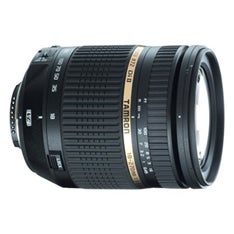Lens Test: Tamron 18-270mm f/3.5-6.3 Di II VC AF
With the broadest zoom range of any interchangeable DSLR lens, this superzoom also packs a Vibration Compensation system.

We may earn revenue from the products available on this page and participate in affiliate programs. Learn more ›
With the broadest zoom range (15X) of any interchangeable lens for DSLRs, this 28-419mm equivalent superzoom ($600, street) also packs a Vibration Compensation system for sharp handheld shooting at long focal lengths or slow shutter speeds.
Made with three hybrid aspheric elements and two elements of low-dispersion glass, it’s available in Canon and Nikon mounts. The latter has a built-in motor, so it can be used on all Nikon bodies with sensors smaller than full-frame, including the D40 and D40X. (Why no other mounts? Most other DSLR bodies have built-in image stabilization, so they don’t need the VC in this Tamron.)
HANDS ON
Slightly lighter than Canon’s and Sigma’s 18-200mm (11X) stabilized superzooms, the lens is very light considering that it reaches well over 400mm (in full-frame terms). While, when racked out, it’s almost an inch longer than Tamron’s nonstabilized 18-250mm, the new lens is still compact enough that it casts a shadow only at its widest settings (18-28mm) when used on a Nikon D90 with its built-in flash.
Well marked, with amply sized, very legible, white-on-black focusing and zoom scales, the lens has a half-inch-wide ring with an underdamped turning action and narrow turning radius for fast, if coarse, manual focusing. The zoom action is adequately damped, though slightly uneven, stiffening as you go out. Autofocus on the Nikon D90 was quiet, moderately fast, and accurate. There are three barrel switches: MF/AF, VC on/off, and a zoom lock at 18mm.
IN THE LAB
Optical bench tests for sharpness and contrast produced SQF numbers in the Excellent range at all tested focal lengths except 270mm, where they dipped into the Good range. The numbers were similar to those of most superzooms and almost identical to those of Tamron’s 18-250mm.
DxO Analyzer 3.0.1 distortion tests found Visible-range barrel distortion at 18mm (0.75%), and pincushioning in the Slight range at 35mm (0.19%), 100mm (0.22%), and 270mm (0.15%) — again about the same as the 18-250mm. The results suggest that Tamron was able to add the extra reach and Vibration Compensation at little or no optical cost.
Light falloff was gone from the corners by f/5 at 18mm. At the other three zoom settings, we found no discernible vignetting at all. This is a noteworthy achievement compared with most of the competition, and it’s a noticeable improvement over the 18-250mm, which showed vignetting at every tested focal length.
Maximum magnification at the uniform close-focusing distance of approximately 15.7 inches ranged from 1:14 at 18mm to a high-powered 1:2.89 at 270mm — significantly stronger than Tamron’s published spec of 1:3.5.
Tests of the Vibration Compensation system found handholding gains of between 1.5 and 3 shutter speeds for three different testers. The results also suggested that, more than with most image-stabilized zooms, users will get the best VC performance from this lens by waiting a full second between shots.
CONCLUSIONS
With a 1-2-3 punch delivered by that unequaled zoom range, Vibration Compensation for handholding, and impressive macro and vignetting performances, this is arguably the single most useful lens available to sub-full-frame digital shooters. Autofocus, while not sluggish, is a little too slow for truly active subjects, and the softening at 270mm may be a deal-killer for photographers who need critically sharp tele images.
Most amateurs, however, could shoot for months, if not years, without ever needing or wanting another lens. You may never need a teleconverter or tripod, either!
SPECIFICATIONS
18-270mm (18.25-267.63mm tested), f/3.5-6.3 (f/3.30-n.a.* tested), 18 elements in 13 groups. Focusing turns 70 degrees clockwise. Zoom ring turns 80 degrees counterclockwise. Focal lengths marked at 18-, 35-, 50-, 70-, 100-, 200-, and 270mm.
• Diagonal view angle: 75-5 degrees.
• Weight: 1.32 lb.
• Filter size: 72mm.
• Mounts: Canon AF, Nikon AF.
• Included: Lenshood.
• Street price: $600.
* Tested measurement not availabledue to instrument limitation.